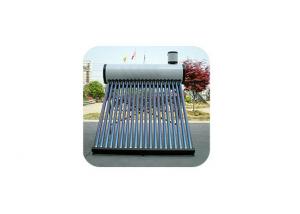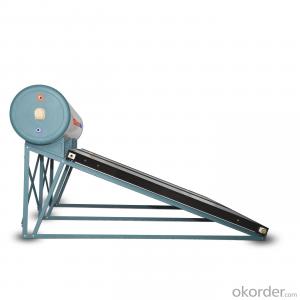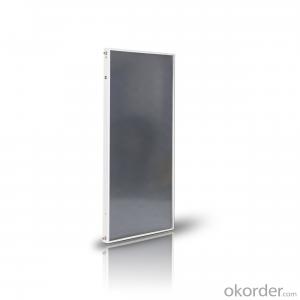Rooftop Pre-Heated Solar Water Heater
- Loading Port:
- China Main Port
- Payment Terms:
- TT or LC
- Min Order Qty:
- 1 Set set
- Supply Capability:
- 5000 Sets per Month set/month
OKorder Service Pledge
Quality Product, Order Online Tracking, Timely Delivery
OKorder Financial Service
Credit Rating, Credit Services, Credit Purchasing
You Might Also Like
Pre-heated solar water heater
1. EN12975, Solar key mark, SRCC, CE, ISO.
2. FREEOEM is welcomed!
3. Delivery time: 10-15days
| Pre-heated Pressurized Solar Water Heater TECHNICAL DATA | ||||||
| WATER STORAGE TANKS | ||||||
| Material of out tank | 0.4mm High quality Painted steel/ Stainless steel. | |||||
| Material of inner tank | 0.4mm food grade SUS304-2B stainless steel. | |||||
| Tank insulating layer | 50 mm high-density polyurethane foamed | |||||
| Inlet and outlet hole | Male G 1/2 | |||||
| Tank size | 480/380mm or customer demand | |||||
| Welding: | Argon arc welding | |||||
| Copper coil size | Dia.12mm*L.40m | |||||
| Coil thickness | 0.8mm | |||||
| Max pressure | Coil max. Working pressure: 0.8Mpa. | |||||
| EVACUATED VACUUM TUBES | ||||||
| Tube structure | All-glass double deck co-axial structure | |||||
| Glass material | High borosilicate 3.3 glass | |||||
| Outer tube dia. & thickness | Ø58±0.7mm; Glass thickness 1.6±0.15mm | |||||
| Inner tube dia.& thickness | Ø47±0.7mm; Glass thickness 1.6±0.15mm | |||||
| Tube size | 58*1800mm | |||||
| Absorptive coating property | Structure | AL/AL-ALN(H)/AL-ALN(L)/ALN or Cu/SS-ALN(H)/SS-ALN(L)/ALN | ||||
| Sediment method | Single target or Three targets - magnetron sputtering plating | |||||
| Specific absorption | 0.90-0.93(AM1.5) / 0.93-0.96(AM1.5) | |||||
| Emission ratio | 0.05-0.075(800C±50C) / 0.04-0.06(800C±50C) | |||||
| Solar irradiation for obtaining a preset water temperature | Φ=58 H≤4.7MJ/m² | H=4.1-4.4MJ/m² / H=3.7-4.2MJ/m² | ||||
| Vacuum tightness | 5.0×10¯³ Pa | |||||
| Idle sunning property parameters | 220-260 m².C/KW / 260-300 m².C/KW | |||||
| Average heat loss coefficient | ULT=0.6~0.7W/(M2.0C) / ULT=0.4~0.6W/(M2.0C) | |||||
| Resistant Hail | ≤25mm | |||||
| Useful life | 15 years | |||||
| BRACKET | ||||||
| Bracket: | Much bigger and stronger galvanized steel / Stainless steel/aluminium alloy. | |||||
| Bracket angle: | flat roof 45 degree.(other degree optional) | |||||
| Fastening pieces: | Made of zinc-coated stainless steel.. | |||||
| MODEL No. | Tube Size | Tube No. | Capacity | Aperture Area | Load Qty 20GP/40HQ | Reommending for family |
| Dia.*L | (litres) | ( m2) | (sets) | (people) | ||
| JXPH-58-20 | 58x1800mm | 20 | 200 | 1.86 | 35/85 | 5 |
| JXPH-58-24 | 58x1800mm | 24 | 240 | 2.23 | 32/72 | 6 |
| JXPH-58-30 | 58x1800mm | 30 | 300 | 2.79 | 26/63 | 7 |
| JXPH-58-36 | 58x1800mm | 36 | 360 | 3.35 | 22/53 | 8 |
- Q: Can a solar water heater be used in areas with shading from trees or nearby buildings?
- Yes, a solar water heater can still be used in areas with shading from trees or nearby buildings, but the efficiency and performance of the system may be affected. Shading can block the sunlight necessary for the solar panels to collect and convert energy, thus reducing the amount of heat generated for heating the water. However, there are some measures that can be taken to mitigate the impact of shading. Firstly, the solar water heater can be installed in an area that receives the most sunlight throughout the day, away from the shade of trees or buildings. This may require careful planning and positioning to ensure maximum exposure to sunlight. Secondly, shading can be minimized by trimming or removing trees that cast significant shadows on the solar panels. This may not be possible in all cases, especially if the trees are protected or if they provide other important benefits such as shade during hot summer months. Alternatively, if shading is caused by nearby buildings, adjusting the angle or tilt of the solar panels can help to optimize sunlight absorption and reduce the impact of shading. In some cases, it may also be possible to install a solar water heater system with multiple panels, allowing for partial shading while still maintaining a reasonable level of energy generation. Overall, while shading can impact the efficiency of a solar water heater, it is still possible to use the system in areas with shading. It may require careful planning, positioning, and potentially some additional measures to optimize sunlight exposure and maximize the performance of the system.
- Q: What is the impact of snow or ice on the performance of a solar water heater?
- The impact of snow or ice on the performance of a solar water heater is generally negative. Snow or ice can block sunlight from reaching the solar collector, reducing the efficiency of the system and potentially causing a decrease in water heating. It can also add weight to the system, potentially causing structural damage or even complete failure. Regular maintenance and snow removal are necessary to ensure optimal performance during winter months.
- Q: How to use solar heating? A reasonable solution?
- Air energy heat pump water heater industry pioneer in the careful cultivation has been gradually recognized by the majority of consumers. Her advanced nature lies in the very energy saving and environmental protection, with other water heater can not be replaced.
- Q: What is a passive solar water heater?
- A passive solar water heater is a system that utilizes the sun's energy to heat water in a natural and energy-efficient manner, without the need for mechanical or electrical components. It typically consists of a storage tank and a series of pipes or tubes, through which water flows and gets heated by the sun's rays. The design of the system allows for maximum absorption of sunlight and minimal heat loss, resulting in cost savings and reduced environmental impact.
- Q: How does the type of water being heated impact the performance of a solar water heater?
- The type of water being heated can impact the performance of a solar water heater in several ways. Hard water, which contains high levels of minerals, can lead to the accumulation of scale inside the solar collector and pipes, reducing the efficiency of heat transfer. Soft water, on the other hand, does not cause scale buildup and allows for better heat transfer. Additionally, the temperature and pH of the water can affect the performance of the solar water heater. Higher water temperatures generally result in improved efficiency, while acidic or alkaline water can cause corrosion and damage to the system components. Therefore, the type of water being heated is an important factor to consider when evaluating the performance of a solar water heater.
- Q: Can a solar water heater be used in apartment buildings?
- Yes, a solar water heater can be used in apartment buildings. However, it may require some modifications to the existing plumbing infrastructure and installation of separate storage tanks or panels for each unit. Additionally, adequate space on the rooftop or another suitable area will be needed to accommodate the solar panels.
- Q: Can a solar water heater be used in areas with high levels of air pollution?
- Yes, a solar water heater can still be used in areas with high levels of air pollution. While air pollution may affect the overall efficiency of the solar panels, the system can still function and generate heat from the sun. However, it is important to regularly clean and maintain the solar panels to ensure optimal performance in such areas.
- Q: How does the versatility of a solar water heater compare to a traditional water heating system?
- The versatility of a solar water heater is generally lower compared to a traditional water heating system. Solar water heaters rely on sunlight to heat the water, which means they are most effective in regions with abundant sunlight. In contrast, traditional water heating systems can be powered by various energy sources such as electricity, gas, or oil, providing more flexibility in terms of installation and usage. Additionally, solar water heaters may require a backup system for cloudy days or during periods of high hot water demand, further limiting their versatility.
- Q: Can a solar water heater be used in areas with limited access to installation services?
- Yes, a solar water heater can be used in areas with limited access to installation services. Solar water heaters are relatively simple systems and can be installed by individuals with basic plumbing and construction skills. Additionally, there are portable and off-grid solar water heater options available that can be easily installed and used in remote areas without access to traditional installation services.
- Q: Can a solar water heater be used in areas with limited access to energy-saving measures?
- Yes, a solar water heater can be used in areas with limited access to energy-saving measures. Solar water heaters are designed to harness the sun's energy to heat water, reducing the reliance on traditional energy sources. They can be installed in areas with limited access to energy-saving measures as long as there is sufficient sunlight available. Solar water heaters are cost-effective, environmentally friendly, and can significantly reduce energy consumption, making them a suitable solution for areas without extensive energy-saving measures.
Guided by business philosophy, our company has experienced success in the three historic periods, noted as brand building, diversification and globalization. It has long attached significance to innovation in satisfying the demands of worldwide consumers and realizing win-win performance between our company and our clients.
1. Manufacturer Overview
| Location | Zhejiang,China |
| Year Established | 2006 |
| Annual Output Value | |
| Main Markets | North America South America Eastern Europe Africa Oceania Mid East Western Europe Central America Domestic Market |
| Company Certifications | ISO9001:2008;CE;CCC |
2. Manufacturer Certificates
| a) Certification Name | |
| Range | |
| Reference | |
| Validity Period |
3. Manufacturer Capability
| a) Trade Capacity | |
| Nearest Port | SHANGHAI,NINGBO |
| Export Percentage | 71% - 80% |
| No.of Employees in Trade Department | 6-10 People |
| Language Spoken: | English, Chinese, Spanish, Portuguese, French, Russian |
| b) Factory Information | |
| Factory Size: | 5,000-10,000 square meters |
| No. of Production Lines | Above 10 |
| Contract Manufacturing | OEM Service Offered Design Service Offered Buyer Label Offered |
| Product Price Range | |
Send your message to us
Rooftop Pre-Heated Solar Water Heater
- Loading Port:
- China Main Port
- Payment Terms:
- TT or LC
- Min Order Qty:
- 1 Set set
- Supply Capability:
- 5000 Sets per Month set/month
OKorder Service Pledge
Quality Product, Order Online Tracking, Timely Delivery
OKorder Financial Service
Credit Rating, Credit Services, Credit Purchasing
Similar products
Hot products
Hot Searches
Related keywords
























